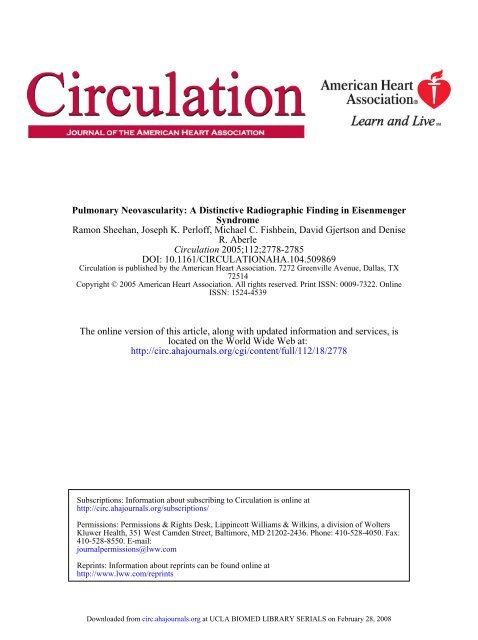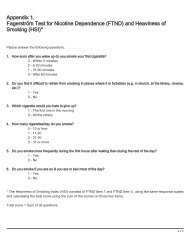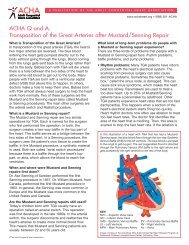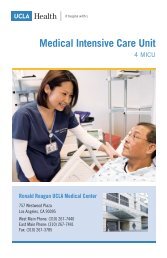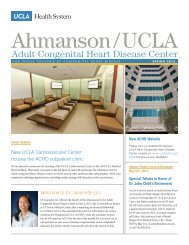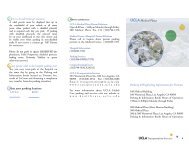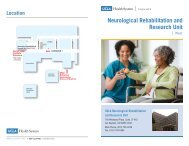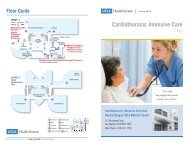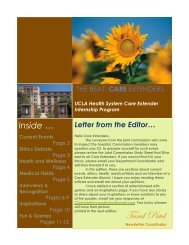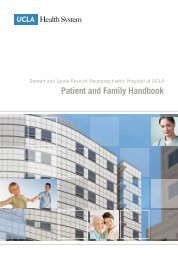Pulmonary Neovascularity A Distinctive Radiographic Finding in ...
Pulmonary Neovascularity A Distinctive Radiographic Finding in ...
Pulmonary Neovascularity A Distinctive Radiographic Finding in ...
You also want an ePaper? Increase the reach of your titles
YUMPU automatically turns print PDFs into web optimized ePapers that Google loves.
<strong>Pulmonary</strong> <strong>Neovascularity</strong>: A <strong>Dist<strong>in</strong>ctive</strong> <strong>Radiographic</strong> <strong>F<strong>in</strong>d<strong>in</strong>g</strong> <strong>in</strong> Eisenmenger<br />
Syndrome<br />
Ramon Sheehan, Joseph K. Perloff, Michael C. Fishbe<strong>in</strong>, David Gjertson and Denise<br />
R. Aberle<br />
Circulation 2005;112;2778-2785<br />
DOI: 10.1161/CIRCULATIONAHA.104.509869<br />
Circulation is published by the American Heart Association. 7272 Greenville Avenue, Dallas, TX<br />
72514<br />
Copyright © 2005 American Heart Association. All rights reserved. Pr<strong>in</strong>t ISSN: 0009-7322. Onl<strong>in</strong>e<br />
ISSN: 1524-4539<br />
The onl<strong>in</strong>e version of this article, along with updated <strong>in</strong>formation and services, is<br />
located on the World Wide Web at:<br />
http://circ.ahajournals.org/cgi/content/full/112/18/2778<br />
Subscriptions: Information about subscrib<strong>in</strong>g to Circulation is onl<strong>in</strong>e at<br />
http://circ.ahajournals.org/subscriptions/<br />
Permissions: Permissions & Rights Desk, Lipp<strong>in</strong>cott Williams & Wilk<strong>in</strong>s, a division of Wolters<br />
Kluwer Health, 351 West Camden Street, Baltimore, MD 21202-2436. Phone: 410-528-4050. Fax:<br />
410-528-8550. E-mail:<br />
journalpermissions@lww.com<br />
Repr<strong>in</strong>ts: Information about repr<strong>in</strong>ts can be found onl<strong>in</strong>e at<br />
http://www.lww.com/repr<strong>in</strong>ts<br />
Downloaded from circ.ahajournals.org at UCLA BIOMED LIBRARY SERIALS on February 28, 2008
Congenital Heart Disease<br />
<strong>Pulmonary</strong> <strong>Neovascularity</strong><br />
A <strong>Dist<strong>in</strong>ctive</strong> <strong>Radiographic</strong> <strong>F<strong>in</strong>d<strong>in</strong>g</strong> <strong>in</strong> Eisenmenger Syndrome<br />
Ramon Sheehan, MD; Joseph K. Perloff, MD; Michael C. Fishbe<strong>in</strong>, MD;<br />
David Gjertson, PhD; Denise R. Aberle, MD<br />
Background—We sought to characterize the dist<strong>in</strong>ctive pulmonary vascular abnormalities seen on chest radiographs and<br />
computed tomography (CT) scans <strong>in</strong> Eisenmenger syndrome.<br />
Methods and Results—Thoracic CT scans, chest radiographs, and cl<strong>in</strong>ical data were reviewed for 24 Eisenmenger<br />
syndrome patients subdivided <strong>in</strong>to those with <strong>in</strong>teratrial (pretricuspid) versus <strong>in</strong>terventricular or great arterial<br />
(posttricuspid) communications and <strong>in</strong> 14 acyanotic patients with pulmonary arterial hypertension (PAH) and no<br />
congenital heart disease. CT scans were scored bl<strong>in</strong>dly by 2 thoracic radiologists for the presence and severity of small,<br />
tortuous, <strong>in</strong>trapulmonary vessels, termed “neovascularity,” lobular ground-glass opacification, and systemic perihilar<br />
and <strong>in</strong>tercostal vessels. Histopathologic lung sections from 5 patients with Eisenmenger syndrome and from 3 patients<br />
with acyanotic PAH were reviewed. Associations between cl<strong>in</strong>ical and imag<strong>in</strong>g features were tested by ANOVA and<br />
2 tests. Kendall’s rank-order coefficient and the Kruskal-Wallis test were used to test for significant differences <strong>in</strong><br />
imag<strong>in</strong>g features between Eisenmenger syndrome and acyanotic PAH. <strong>Neovascularity</strong> on chest radiographs was more<br />
common <strong>in</strong> Eisenmenger syndrome than acyanotic PAH, but differences were not significant. On CT, neovascularity,<br />
lobular ground-glass opacification, and hilar and <strong>in</strong>tercostal systemic collaterals were more prevalent <strong>in</strong> Eisenmenger<br />
syndrome, with severity greater <strong>in</strong> posttricuspid communications. Three previously undescribed vascular lesions were<br />
identified histologically <strong>in</strong> Eisenmenger syndrome: malformed, dilated, muscular arteries with<strong>in</strong> alveolar septa;<br />
congested capillaries with<strong>in</strong> alveolar walls; and congested capillaries with<strong>in</strong> the walls of medium-size, muscular<br />
pulmonary arteries. These lesions may correspond to the dist<strong>in</strong>ctive vascular abnormalities observed on chest<br />
radiographs and CT scans.<br />
Conclusions—<strong>Dist<strong>in</strong>ctive</strong> vascular lesions on chest radiographs and CT scans <strong>in</strong> Eisenmenger syndrome appear to be<br />
correlated histologically with collateral vessels that develop more extensively with posttricuspid communications.<br />
(Circulation. 2005;112:2778-2785.)<br />
Key Words: collateral circulation heart defects, congenital hypertension, pulmonary lung imag<strong>in</strong>g<br />
Heath and Edwards classified the histopathologic features<br />
of pulmonary hypertension <strong>in</strong> 1958. 1 Attention focused<br />
on 6 grades of structural abnormalities <strong>in</strong> muscular pulmonary<br />
arteries and arterioles. Plexogenic pulmonary arteriopathy,<br />
the most severe grade, was equally prevalent <strong>in</strong> Eisenmenger<br />
syndrome and primary pulmonary hypertension<br />
(PPH), 2 types of pulmonary vascular disease that could be<br />
dist<strong>in</strong>guished by differences <strong>in</strong> elastic tissues of the pulmonary<br />
trunk and proximal pulmonary arteries. 2<br />
In Eisenmenger syndrome, we identified dist<strong>in</strong>ctive, micronodular,<br />
serpig<strong>in</strong>ous opacities on chest radiographs and<br />
computed tomography (CT) scans and assigned the term<br />
“neovascularity” to these hitherto-undescribed lesions because<br />
they did not correspond to known patterns of pulmonary<br />
arterial, pulmonary venous, or collateral vascularity. The<br />
histopathology of these opacities and its relation to plexogenic<br />
pulmonary arteriopathy is unknown. Nor is it known<br />
why these dist<strong>in</strong>ctive vascular abnormalities occur <strong>in</strong> only<br />
some types of pulmonary hypertension.<br />
We studied the dist<strong>in</strong>ctive vascular lesions on chest<br />
radiographs and chest CT scans <strong>in</strong> patients with Eisenmenger<br />
syndrome and <strong>in</strong> patients with acyanotic pulmonary<br />
artery hypertension (PAH) due to PPH or acquired<br />
forms of acyanotic PAH 2 and correlated our f<strong>in</strong>d<strong>in</strong>gs with<br />
cl<strong>in</strong>ical and histopathologic data. Different vascular patterns<br />
<strong>in</strong> pulmonary hypertension of different etiologies can<br />
be recognized on chest radiographs and CT scans. These<br />
patterns appear to be correlated with the histopathologic<br />
lesions that differ from Heath-Edwards plexogenic pulmonary<br />
arteriopathy.<br />
Received November 24, 2004; revision received June 8, 2005; accepted July 29, 2005.<br />
From the Division of Thoracic Imag<strong>in</strong>g (R.S., D.R.A.), Department of Radiological Sciences; the Division of Cardiology (J.K.P.), Department of<br />
Medic<strong>in</strong>e; and the Divisions of Surgical Pathology (M.C.F.) and Laboratory Medic<strong>in</strong>e (D.G.), Department of Pathology and Laboratory Medic<strong>in</strong>e, David<br />
Geffen School of Medic<strong>in</strong>e at UCLA, Los Angeles, Calif.<br />
Repr<strong>in</strong>ts requests to Denise R. Aberle, MD, Division of Thoracic Imag<strong>in</strong>g, Department of Radiological Sciences, David Geffen School of Medic<strong>in</strong>e<br />
at UCLA, 10833 Le Conte Ave, Los Angeles, CA 90095.1721. E-mail daberle@mednet.ucla.edu<br />
© 2005 American Heart Association, Inc.<br />
Circulation is available at http://www.circulationaha.org<br />
DOI: 10.1161/CIRCULATIONAHA.104.509869<br />
Downloaded from circ.ahajournals.org at UCLA BIOMED 2778 LIBRARY SERIALS on February 28, 2008
Sheehan et al <strong>Pulmonary</strong> <strong>Neovascularity</strong> <strong>in</strong> Eisenmenger Syndrome 2779<br />
Methods<br />
Patient Selection<br />
Twenty-four consecutive adults, 10 men and 14 women aged 22 to<br />
53 years (mean, 392), with unoperated cyanotic congenital heart<br />
disease were selected from the Ahmanson/UCLA Adult Congenital<br />
Heart Disease Center Registry after referral for CT pulmonary<br />
angiography performed between May 1994 and September 2000 <strong>in</strong><br />
anticipation of lung transplantation. Six patients had 1 CT scan<br />
performed; <strong>in</strong> these cases, the analyzed scan was the 1 done closest<br />
to diagnostic echocardiography. Imag<strong>in</strong>g data were also collected<br />
from 14 consecutive patients 18 years with acyanotic PAH, both<br />
primary and acquired forms, who had CT pulmonary angiography<br />
performed between April 1995 and September 1998 with<strong>in</strong> 24<br />
months of the diagnosis of PAH.<br />
The congenital cardiac defects <strong>in</strong> Eisenmenger syndrome were<br />
established by transthoracic echocardiography with color flow imag<strong>in</strong>g<br />
and Doppler <strong>in</strong>terrogation performed on average with<strong>in</strong><br />
6.07.1 months of the CT scans. <strong>Pulmonary</strong> hypertension <strong>in</strong> the<br />
patients with acyanotic PAH was established by transthoracic echocardiography<br />
and cardiac catheterization performed with<strong>in</strong> 3.47.1<br />
months of the CT scans. 3<br />
Age and sex data were secured from medical records. Systemic<br />
arterial oxygen saturation and hematocrit/hemoglob<strong>in</strong> values were<br />
recorded with<strong>in</strong> 3 weeks of imag<strong>in</strong>g studies. The UCLA <strong>in</strong>stitutional<br />
review board exempted this retrospective study from the approval<br />
process or patient <strong>in</strong>formed consent.<br />
Image Acquisition<br />
Chest Radiographs<br />
Upright posteroanterior and lateral chest radiographs were taken at a<br />
72-<strong>in</strong>ch source-to-image distance with high-kilovoltage techniques<br />
(110 to 140 kV) with various screen-film or computed radiography<br />
receptor systems of 200 speed.<br />
CT Scans<br />
CT pulmonary angiograms were obta<strong>in</strong>ed on either an Imatron<br />
Evolution electron beam CT (EBT) scanner (Imatron, Inc) or a GE<br />
HiSpeed CT/i scanner (General Electric Medical Systems). Scans<br />
were acquired at suspended maximal <strong>in</strong>spiration. Patients unable to<br />
breath-hold were preferentially studied at quiet respiration on the<br />
Imatron EBT scanner. Each study <strong>in</strong>cluded an <strong>in</strong>itial noncontrast<br />
sequence to exclude pulmonary vascular calcifications, followed by<br />
<strong>in</strong>travenous contrast-enhanced vascular sequences from 1 cm above<br />
the superior marg<strong>in</strong> of the transverse aorta to 1 cm above the lower<br />
of the 2 hemidiaphragms.<br />
Initial non–contrast-enhanced, cont<strong>in</strong>uous-volume datasets on the<br />
EBT scanner were acquired through the thorax accord<strong>in</strong>g to a<br />
standardized protocol of 6-mm collimation, 6-mm table <strong>in</strong>crementation,<br />
and 300-ms exposure. Images were reconstructed with use of a<br />
high-spatial-frequency algorithm. Vascular sequences were performed<br />
<strong>in</strong> s<strong>in</strong>gle-slice, cont<strong>in</strong>uous-volume mode with 3-mm collimation,<br />
2-mm table <strong>in</strong>crementation, 100- to 200-ms exposure, and a<br />
standard reconstruction algorithm.<br />
Studies acquired on the GE HiSpeed CT/i scanner consisted of an<br />
<strong>in</strong>itial noncontrast sequence of 120 kV, 200 to 260 mA, 0.8- to<br />
1.0-mm gantry rotation speed, 5-mm collimation, pitch of 1.5:1 to<br />
2:1, 5-mm reconstruction <strong>in</strong>terval, and a bone reconstruction algorithm.<br />
This was followed by a vascular sequence after adm<strong>in</strong>istration<br />
of <strong>in</strong>travenous contrast of 3-mm collimation, pitch of 2:1, 2-mm<br />
reconstruction <strong>in</strong>terval, and a standard reconstruction algorithm.<br />
Images were reviewed on softcopy with both mediast<strong>in</strong>al (width, 400<br />
Hounsfield units [HU]; level, 40 HU) and lung (width, 1600 HU;<br />
level, 550 HU) w<strong>in</strong>dow sett<strong>in</strong>gs.<br />
For all vascular sequences, a peripheral catheter was <strong>in</strong>serted <strong>in</strong>to<br />
a large forearm or antecubital ve<strong>in</strong> and avoid<strong>in</strong>g <strong>in</strong>troduction of air.<br />
Omnipaque 350 (Amersham Health) was adm<strong>in</strong>istered by mechanical<br />
<strong>in</strong>jection at standard flow rates of 3 to 4 mL/s, averag<strong>in</strong>g 90 to<br />
140 mL total. Vascular sequences were <strong>in</strong>itiated 25 to 30 seconds<br />
after the start of the contrast bolus.<br />
Figure 1. Chest radiograph of a 32-year-old man with a nonrestrictive<br />
VSD and Eisenmenger syndrome. Small, nodular opacities<br />
<strong>in</strong> the lungs correspond to pulmonary neovascularity grade<br />
2. Enlarged central pulmonary arteries are <strong>in</strong>dicative of PAH.<br />
Image Interpretation<br />
Two subspecialty-tra<strong>in</strong>ed thoracic radiologists (R.S., D.R.A.)<br />
<strong>in</strong>dependently reviewed all chest radiographs and CT images.<br />
Both were aware that all patients were pulmonary hypertensive<br />
but were bl<strong>in</strong>ded to other cl<strong>in</strong>ical and histological data. Image<br />
analyses were standardized so that lung w<strong>in</strong>dows were reviewed<br />
first, enabl<strong>in</strong>g all relevant observations to be recorded before<br />
soft-tissue w<strong>in</strong>dows of the cardiac lesions were revealed. Chest<br />
radiographs and CT images were read <strong>in</strong> sett<strong>in</strong>gs separated by at<br />
least 12 weeks to ensure that recall would not affect visual<br />
scor<strong>in</strong>g. Scores were compared and <strong>in</strong>consistencies reconciled by<br />
agreement after all images had been reviewed.<br />
Chest radiographs and CT scans from 3 patients with cyanotic<br />
congenital heart disease outside the time period under consideration<br />
were used to establish visual standards for develop<strong>in</strong>g semiquantitative<br />
scor<strong>in</strong>g systems for the presence and severity of specific<br />
imag<strong>in</strong>g features by us<strong>in</strong>g pr<strong>in</strong>ciples developed for other visual<br />
scor<strong>in</strong>g systems. 4 These visual standards conta<strong>in</strong>ed features spann<strong>in</strong>g<br />
the range of features be<strong>in</strong>g scored on the study images and were<br />
available for reference dur<strong>in</strong>g image analysis. Chest radiographs<br />
were scored for the presence and severity of small, nodular opacities<br />
with<strong>in</strong> the lungs on a 4-po<strong>in</strong>t, semiquantitative grad<strong>in</strong>g system:<br />
0no opacities, 1opacities mildly pronounced, 2opacities moderately<br />
pronounced, 3opacities markedly pronounced (Figure 1).<br />
Similarly, CT scans were scored on a 4-po<strong>in</strong>t, semiquantitative<br />
grad<strong>in</strong>g system (0absent, 1mild, 2moderate, 3extensive) to<br />
determ<strong>in</strong>e the presence and severity of each of the follow<strong>in</strong>g vascular<br />
patterns: (1) <strong>Neovascularity</strong>, def<strong>in</strong>ed as t<strong>in</strong>y, micronodular, serpig<strong>in</strong>ous<br />
<strong>in</strong>trapulmonary vessels often <strong>in</strong> the subpleural lung or <strong>in</strong><br />
proximity to centrilobular arterioles, cours<strong>in</strong>g <strong>in</strong> directions <strong>in</strong>consistent<br />
with known arteriolar anatomy (Figure 2A and 2B). (2) Lobular<br />
ground-glass, def<strong>in</strong>ed as hazy, <strong>in</strong>creased lung attenuation at the<br />
center of secondary lobules fad<strong>in</strong>g to normal attenuation at the<br />
lobular marg<strong>in</strong> (Figure 3). (3) Hilar collateral vessels, def<strong>in</strong>ed as<br />
small, serpig<strong>in</strong>ous, vascular channels cours<strong>in</strong>g <strong>in</strong> the car<strong>in</strong>al or<br />
bilateral hilar regions adjacent to ma<strong>in</strong>stem, lobar, or <strong>in</strong>terlobar<br />
arteries or bronchi (Figure 4). (4) Intercostal collaterals, def<strong>in</strong>ed as<br />
small, serpig<strong>in</strong>ous, vascular channels cours<strong>in</strong>g <strong>in</strong> chest wall soft<br />
tissues <strong>in</strong> proximity to pleural surfaces (Figure 5). These appeared as<br />
“bead<strong>in</strong>g” along the visceral pleural marg<strong>in</strong> and occasionally entered<br />
the lung to jo<strong>in</strong> <strong>in</strong>trapulmonary vessels, form<strong>in</strong>g serpig<strong>in</strong>ous neovascularity<br />
<strong>in</strong> the lung periphery (Figure 6A and 6B). Intercostal<br />
vessels had to be <strong>in</strong>creased <strong>in</strong> number to be judged abnormal.<br />
Downloaded from circ.ahajournals.org at UCLA BIOMED LIBRARY SERIALS on February 28, 2008
2780 Circulation November 1, 2005<br />
Figure 4. Soft-tissue w<strong>in</strong>dows of a CT scan <strong>in</strong> a 28-year-old<br />
woman with Eisenmenger syndrome and a nonrestrictive VSD.<br />
Multiple small, hilar vessels course <strong>in</strong> the subcar<strong>in</strong>al and bilateral<br />
hilar regions (arrows) adjacent to bronchovascular bundles.<br />
Figure 2. A, Axial CT scan with lung w<strong>in</strong>dows <strong>in</strong> a 26-year-old<br />
woman with Eisenmenger syndrome and double-outlet right<br />
ventricle. Numerous micronodules are <strong>in</strong> cont<strong>in</strong>uity with peripheral<br />
pulmonary arteries (arrows) and correspond to grade 3 neovascularity.<br />
B, Axial CT scan with lung w<strong>in</strong>dows <strong>in</strong> a 35-year-old<br />
woman with Eisenmenger syndrome, complete transposition of<br />
the great arteries, and a nonrestrictive VSD. Numerous small,<br />
serpig<strong>in</strong>ous neovessels appear with<strong>in</strong> the lungs (arrows) as<br />
grade 3 neovascularity.<br />
<strong>Neovascularity</strong> and lobular ground-glass were scored on lung<br />
w<strong>in</strong>dows, whereas collateral vessels were scored on soft-tissue<br />
w<strong>in</strong>dows. <strong>Pulmonary</strong> artery thrombus, recanalized thrombus, pulmonary<br />
artery mural calcifications, and <strong>in</strong>cidental cardiopulmonary<br />
f<strong>in</strong>d<strong>in</strong>gs were recorded as present or absent.<br />
Histopathology<br />
Histological material was studied from 5 patients with Eisenmenger<br />
syndrome, 1 with an ostium secundum atrial septal defect (ASD) and<br />
4 with posttricuspid lesions, and <strong>in</strong> 3 patients with acyanotic PPH.<br />
The lung specimens from patients with PPH were obta<strong>in</strong>ed dur<strong>in</strong>g<br />
surgery for lung transplantation, whereas Eisenmenger syndrome<br />
specimens were obta<strong>in</strong>ed at necropsy.<br />
Lung specimens were fixed <strong>in</strong> formal<strong>in</strong> and embedded <strong>in</strong> paraff<strong>in</strong>.<br />
Sections of 5-m thickness were sta<strong>in</strong>ed with hematoxyl<strong>in</strong>-eos<strong>in</strong> for<br />
light microscopy. All sections were analyzed for the follow<strong>in</strong>g<br />
vascular lesions: (1) medial hypertrophy, (2) <strong>in</strong>timal proliferation,<br />
(3) plexiform lesions, and (4) vascular dilatation lesions. Vascular<br />
lesions not correspond<strong>in</strong>g to these patterns were specifically recorded.<br />
All specimens were reviewed by the same cardiopulmonary<br />
pathologist (M.C.F.). The number of vascular lesions was scored on<br />
<strong>in</strong>dividual histological sections accord<strong>in</strong>g to the same 4-po<strong>in</strong>t,<br />
semiquantitative grad<strong>in</strong>g system used to grade vascular lesions on<br />
CT. Systematic sampl<strong>in</strong>g or scor<strong>in</strong>g throughout the lungs was not<br />
possible, nor was it possible to correlate lung specimens directly with<br />
<strong>in</strong> vivo CT image data.<br />
Figure 3. Axial CT scan with lung w<strong>in</strong>dows <strong>in</strong> a 42-year-old man<br />
with Eisenmenger syndrome and a nonrestrictive VSD. A dist<strong>in</strong>ctive,<br />
hazy, lobular, ground-glass pattern with <strong>in</strong>creased attenuation<br />
appears at the center of secondary lobules (arrows), fad<strong>in</strong>g<br />
at the marg<strong>in</strong>s.<br />
Figure 5. Soft-tissue w<strong>in</strong>dows of a contrast-enhanced CT scan<br />
<strong>in</strong> a 50-year-old man with Eisenmenger syndrome and a nonrestrictive<br />
VSD. Multiple bilateral, <strong>in</strong>tercostal, collateral vessels<br />
appear along the posterior and right lateral chest walls (arrows).<br />
Downloaded from circ.ahajournals.org at UCLA BIOMED LIBRARY SERIALS on February 28, 2008
Sheehan et al <strong>Pulmonary</strong> <strong>Neovascularity</strong> <strong>in</strong> Eisenmenger Syndrome 2781<br />
Figure 6. A and B, Lung w<strong>in</strong>dows of a CT scan <strong>in</strong> a 36-year-old<br />
man with Eisenmenger syndrome and a nonrestrictive VSD.<br />
Small extrapulmonary, left chest wall vessels are <strong>in</strong> cont<strong>in</strong>uity<br />
with peripheral pulmonary vessels. A, The left chest wall vessels<br />
appear as “bead<strong>in</strong>g” along the lateral pleural surface (arrows)<br />
and B, penetrate the lung to connect with small serpig<strong>in</strong>ous,<br />
<strong>in</strong>trapulmonary neovessels.<br />
Statistical Methods<br />
Associations between <strong>in</strong>dividual chest radiographic or CT f<strong>in</strong>d<strong>in</strong>gs<br />
and age, sex, systemic arterial oxygen saturation, hematocrit, and<br />
hemodynamic data were tested by ANOVA and a 2 test for<br />
cont<strong>in</strong>uous and categorical variables, respectively. To assess for<br />
significant differences <strong>in</strong> chest radiographic and CT f<strong>in</strong>d<strong>in</strong>gs between<br />
patients with Eisenmenger syndrome versus acyanotic PAH,<br />
Kendall’s rank-order correlation coefficient ( b ) was computed, and<br />
the Kruskal-Wallis test was applied to the ord<strong>in</strong>al data. To highlight<br />
differences, semiquantitative scores for chest radiographic and CT<br />
features for each group were also dichotomized <strong>in</strong> 2 ways: (1)<br />
negative (grade 0) versus positive (grades 1 to 3) and (2) mild (grade<br />
1) versus extensive (grades 2 and 3). All probability values were 2<br />
sided; after allow<strong>in</strong>g for multiple comparison via Bonferroni adjustment,<br />
statistical significance was set at P0.004.<br />
To analyze differences <strong>in</strong> CT features <strong>in</strong> Eisenmenger syndrome,<br />
these patients were further subdivided <strong>in</strong>to those with pretricuspid<br />
lesions 5,6 versus those with posttricuspid lesions (ventricular septal<br />
defects [VSDs] and/or great arterial communications). Because of<br />
the small numbers of patients, results were expressed as percentages<br />
along with exact (b<strong>in</strong>omial) 95% confidence <strong>in</strong>tervals (CIs); tests of<br />
significance for proportions among comparative grades were not<br />
done. Because correlations between histological data and the CT<br />
image data were not possible, no attempt was made to analyze the<br />
histological data for statistical significance.<br />
Results<br />
Cl<strong>in</strong>ical Features<br />
Among 24 patients with Eisenmenger syndrome, echocardiography<br />
disclosed a pretricuspid lesion (ostium secundum<br />
ASD) <strong>in</strong> 7 patients and posttricuspid lesions <strong>in</strong> 17, <strong>in</strong>clud<strong>in</strong>g<br />
VSD <strong>in</strong> 9, truncus arteriosus <strong>in</strong> 2, and 1 each with patent<br />
ductus arteriosus (PDA), PDA with ASD, VSD with PDA,<br />
double-outlet right ventricle with VSD, complete transposition<br />
of the great arteries with VSD/ASD/PDA, and endocardial<br />
cushion defect with nonrestrictive VSD. The 7 patients<br />
with pretricuspid lesions were believed to represent the<br />
co<strong>in</strong>cidence of PPH and ASD or stretched patent foramen<br />
ovale. 5,6<br />
Transcutaneous systemic arterial oxygen saturations <strong>in</strong><br />
Eisenmenger syndrome ranged from 68% to 87% (mean,<br />
786%), and iron-replete hematocrit levels (Beckman<br />
Coulter Inc) ranged from 58 to 71 gm/dL (mean, 644).<br />
Right ventricular systolic pressures by echocardiography<br />
were at systemic level <strong>in</strong> Eisenmenger syndrome patients<br />
with posttricuspid lesions; right ventricular/pulmonary artery<br />
systolic pressures ranged from 102 to 138 mm Hg <strong>in</strong> those<br />
with pretricuspid lesions.<br />
The 14 patients with acyanotic PAH <strong>in</strong>cluded 2 men and 12<br />
women aged 20 to 76 years (mean, 444). Eight of 14 met<br />
the cl<strong>in</strong>ical and echocardiographic criteria for PPH. 5 The<br />
rema<strong>in</strong><strong>in</strong>g 6 patients had acquired pulmonary hypertension<br />
caused by systemic or parenchymal disease, <strong>in</strong>clud<strong>in</strong>g 2 with<br />
chronic obstructive pulmonary disease, 2 with systemic lupus<br />
erythematosus, 1 with chronic thromboembolic disease, and 1<br />
with portal hypertension. Transcutaneous systemic arterial<br />
oxygen saturation <strong>in</strong> the 14 patients with acyanotic PAH was<br />
96%, hematocrits ranged from 33 to 44 mg/dL (mean,<br />
372), and echocardiographic right ventricular systolic pressures<br />
ranged from 42 to 118 mm Hg (mean, 839).<br />
There were no significant associations between chest<br />
radiographic or CT features and age, sex, systemic arterial<br />
oxygen saturation, hematocrit, or right ventricular systolic<br />
pressure <strong>in</strong> the 2 major groups (Eisenmenger syndrome and<br />
acyanotic PAH).<br />
Chest <strong>Radiographic</strong> <strong>F<strong>in</strong>d<strong>in</strong>g</strong>s<br />
Chest radiographs were available for review <strong>in</strong> 26 patients.<br />
Small, nodular, vascular opacities were visible on chest<br />
radiographs of 12 of 17 (71%) with Eisenmenger syndrome<br />
and 3 of 9 (33%) with acyanotic PAH, but the difference was<br />
not significant (Table 1).<br />
TABLE 1.<br />
Frequency and Extent of Nodular Opacities on Chest Radiographs (N26*)<br />
<strong>Radiographic</strong> Grad<strong>in</strong>g<br />
Patient Category 0 1 2 3<br />
Correlation†<br />
Patients Graded<br />
as Positive<br />
(Grades 1–3)<br />
Patients Graded<br />
as Severe<br />
(Grades 2 and 3)<br />
Acyanotic PAH 6 3 0 0 0.430.13 (P0.02) 3/9 (33%) 0/9 (0%)<br />
Eisenmenger syndrome 5 4 5 3 12/17 (71%) 8/17 (47%)<br />
Numbers <strong>in</strong> parentheses represent percentages of total positive.<br />
*Chest radiographs were available for 26 of the 38 patients.<br />
†Kendall’s b along with its asymptotic SE. The P value from the Kruskal-Wallis test of equal proportions of grad<strong>in</strong>g<br />
ranks is presented parenthetically. Statistical significance was P0.004.<br />
Downloaded from circ.ahajournals.org at UCLA BIOMED LIBRARY SERIALS on February 28, 2008
2782 Circulation November 1, 2005<br />
TABLE 2.<br />
Frequency and Extent of CT Abnormalities Among Patients (N38)<br />
CT Score of Extent<br />
Patients Graded<br />
as Positive<br />
Patients Graded<br />
as Severe<br />
CT Observation<br />
0 1 2 3 Correlation* (Grades 1–3) (Grades 2 and 3)<br />
Nodular, serpig<strong>in</strong>ous pulmonary vessels<br />
Acyanotic PAH 11 2 1 0 0.680.08 (P0.001) 3/14 (21%) 1/14 (7%)<br />
Eisenmenger syndrome 1 7 4 12 23/24 (96%) 16/24 (67%)<br />
Pretricuspid (ASD) 1 5 0 1 6/7 (86%) 1/7 (14%)<br />
Posttricuspid 0 2 4 11 17/17 (100%) 15/17 (88%)<br />
Lobular ground-glass<br />
Acyanotic PAH 13 0 1 0 0.480.11 (P0.002) 1/14 (7%) 1/14 (7%)<br />
Eisenmenger syndrome 9 9 1 5 15/24 (62%) 6/24 (25%)<br />
Pretricuspid (ASD) 3 4 0 0 4/7 (57%) 0/7 (0%)<br />
Posttricuspid 6 5 1 5 11/17 (65%) 6/17 (35%)<br />
Hilar and <strong>in</strong>tercostal collaterals<br />
Acyanotic PAH 6 5 2 1 0.650.09 (P0.001) 8/14 (57%) 3/14 (21%)<br />
Eisenmenger syndrome 0 4 3 17 24/24 (100%) 20/24 (83%)<br />
Pretricuspid (ASD) 0 2 0 5 7/7 (100%) 5/7 (71%)<br />
Posttricuspid 0 2 3 12 17/17 (100%) 15/17 (88%)<br />
Numbers <strong>in</strong> parentheses represent percentages of total positive.<br />
*Kendall’s b along with its asymptotic SE. The P value from the Kruskal-Wallis test of equal proportions of grad<strong>in</strong>g ranks is<br />
presented parenthetically. Statistical significance was P0.004.<br />
CT <strong>F<strong>in</strong>d<strong>in</strong>g</strong>s<br />
Overall, the CT features of neovascularity, lobular groundglass,<br />
and hilar/<strong>in</strong>tercostal collaterals differed significantly<br />
between patients with Eisenmenger syndrome and those with<br />
acyanotic PAH, be<strong>in</strong>g present more commonly and with<br />
greater severity <strong>in</strong> Eisenmenger syndrome (correlations<br />
equaled 0.68, 0.48, and 0.65, respectively’ Table 2).<br />
<strong>Neovascularity</strong> was present on CT scans <strong>in</strong> 23 of 24 (96%)<br />
of Eisenmenger patients and <strong>in</strong> 3 of 14 (21%) of acyanotic<br />
PAH patients (Table 2). Moreover, among Eisenmenger<br />
patients, neovascularity was more severe (grade 2 or 3) <strong>in</strong><br />
posttricuspid lesions (15/17, or 88%; 95% CI, 64% to 89%)<br />
than <strong>in</strong> pretricuspid lesions (1/7, or 14%; 95% CI, 0% to<br />
58%).<br />
Lobular ground-glass was a CT feature <strong>in</strong> 15 of 24 patients<br />
(62%) with Eisenmenger syndrome versus only 1 of 14<br />
patients (7%) with acyanotic PAH (Table 2). When Eisenmenger<br />
syndrome patients were subdivided, the magnitude of<br />
this difference was unchanged: lobular ground-glass of any<br />
severity (grades 1 to 3) was seen <strong>in</strong> 11 of 17 patients (65%;<br />
95% CI, 38% to 86%) with posttricuspid lesions and <strong>in</strong> 4 of<br />
7 patients (57%; 95% CI, 18% to 90%) with pretricuspid<br />
lesions. Severe grades of lobular ground-glass were found <strong>in</strong><br />
0 of 7 (0%; 95% CI, 0% to 41%) and 6 of 17 (35%; 95% CI,<br />
14% to 62%) Eisenmenger syndrome patients with pretricuspid<br />
and posttricuspid lesions, respectively.<br />
There were significantly <strong>in</strong>creased numbers of small perihilar<br />
and <strong>in</strong>tercostal collaterals <strong>in</strong> all Eisenmenger syndrome<br />
patients and <strong>in</strong> 8 of 14 (57%) patients with acyanotic PAH<br />
(Table 2). Aga<strong>in</strong>, the more severe grades of collaterals<br />
(grades 2 and 3) were more common among Eisenmenger<br />
syndrome patients with posttricuspid lesions (15/17, or 88%;<br />
95% CI, 64% to 98%) than <strong>in</strong> those with pretricuspid lesions<br />
(5/7, or 71%; 95% CI, 29% to 96%). There was no significant<br />
relation between the presence and severity of hilar or <strong>in</strong>tercostal<br />
collaterals and the presence and severity of neovascularity<br />
or lobular ground-glass (data not shown).<br />
Histological Observations<br />
Three patients with acyanotic PPH from whom histological<br />
material was available had medial hypertrophy and <strong>in</strong>timal<br />
proliferation but no plexiform lesions. There was a large,<br />
recanalized thrombus with<strong>in</strong> the proximal pulmonary arteries<br />
<strong>in</strong> 1 patient.<br />
Medial hypertrophy and <strong>in</strong>timal proliferation were present<br />
<strong>in</strong> 3 of 5 Eisenmenger syndrome patients. Classic plexiform<br />
lesions correspond<strong>in</strong>g to Heath-Edwards grade 4 were identified<br />
<strong>in</strong> specimens from 3 patients (Figure 7), and vascular<br />
dilatation and advanced lesions of plexiform pulmonary<br />
arteriopathy were present <strong>in</strong> all 5 Eisenmenger syndrome<br />
patients.<br />
In Eisenmenger syndrome, 3 previously undescribed vascular<br />
lesions were identified by light microscopy. Two of the<br />
lesions <strong>in</strong>volved abnormal capillaries. The first consisted of<br />
numerous dilated, congested capillaries with<strong>in</strong> adventitial<br />
tissue surround<strong>in</strong>g medium-size, muscular, pulmonary arteries<br />
(Figure 7A). The second consisted of markedly dilated,<br />
congested capillaries with<strong>in</strong> alveolar tissues (Figure 7B). The<br />
third lesion, which consisted of clusters of abnormally dilated,<br />
tortuous, muscular arteries with<strong>in</strong> alveolar septa (Figure<br />
7C), was visible on slide preparations without magnification<br />
and appeared to represent the small, tortuous,<br />
neovascularity vessels observed on CT. Figure 7D shows a<br />
plexiform lesion of hypertensive pulmonary arteriopathy.<br />
Discussion<br />
The histological types of pulmonary vascular disease described<br />
by Heath and Edwards are equally prevalent <strong>in</strong><br />
Downloaded from circ.ahajournals.org at UCLA BIOMED LIBRARY SERIALS on February 28, 2008
Sheehan et al <strong>Pulmonary</strong> <strong>Neovascularity</strong> <strong>in</strong> Eisenmenger Syndrome 2783<br />
Figure 7. Microscopic sections from a<br />
man with Eisenmenger syndrome and a<br />
nonrestrictive VSD. A, Clusters of dilated,<br />
tortuous, muscular arteries with<strong>in</strong> alveolar<br />
septa, the latter of which were visible<br />
without magnification and resembled the<br />
neovessels observed on CT. B, Markedly<br />
dilated, congested capillaries with<strong>in</strong> the<br />
alveolar tissues. C, A markedly dilated,<br />
vascular lesion consist<strong>in</strong>g of congested<br />
capillaries with<strong>in</strong> the adventitial tissue<br />
surround<strong>in</strong>g a medium-size, muscular,<br />
pulmonary artery (PA). These lesions differed<br />
dist<strong>in</strong>ctly from plexiform lesions of<br />
hypertensive pulmonary arteriopathy (D),<br />
with dilated channels and foci of prom<strong>in</strong>ent<br />
endothelial proliferation (all H&E<br />
sta<strong>in</strong>, orig<strong>in</strong>al magnifications: A100,<br />
B200, C40, D400.<br />
Eisenmenger syndrome and acyanotic PAH. 1,7–13 The dist<strong>in</strong>ctive<br />
radiographic neovascularity lesions described here<strong>in</strong> are<br />
significantly more frequent <strong>in</strong> Eisenmenger syndrome and are<br />
most severe <strong>in</strong> Eisenmenger syndrome with posttricuspid<br />
right-to-left shunts at the ventricular or great arterial level.<br />
Chest radiographs disclosed dist<strong>in</strong>ctive nodular opacities<br />
with<strong>in</strong> the lungs. On CT, neovascularity appeared as small,<br />
nodular, and serpig<strong>in</strong>ous vessels <strong>in</strong> the lung periphery,<br />
occurr<strong>in</strong>g <strong>in</strong> conjunction with lobular ground-glass opacification.<br />
In Eisenmenger syndrome, <strong>in</strong>creased systemic arterial<br />
collateral vessels were seen <strong>in</strong> the hilar and <strong>in</strong>tercostal<br />
regions; the <strong>in</strong>tercostal vessels sometimes penetrated the lung<br />
and contributed to neovascularity.<br />
In Eisenmenger syndrome, we report previously undescribed<br />
histological vascular lesions characterized by marked<br />
capillary dilatation and congestion <strong>in</strong> alveolar spaces and <strong>in</strong><br />
the adventitial tissue surround<strong>in</strong>g small, muscular arteries.<br />
Abnormal clusters of small, muscular arteries were visible<br />
with<strong>in</strong> the alveolar walls without magnification and had the<br />
dist<strong>in</strong>ctive serpig<strong>in</strong>ous morphology of neovascularity seen on<br />
CT. Although direct radiological/histopathologic confirmation<br />
was not possible, the dist<strong>in</strong>ctive neovascularity lesions<br />
suggest collateralization around t<strong>in</strong>y resistance vessels rather<br />
than Heath-Edwards lesions of plexogenic pulmonary arteriopathy.<br />
Lobular ground-glass may be an <strong>in</strong>direct reflection of<br />
collateral flow below the limits of macroscopic resolution,<br />
correlat<strong>in</strong>g with dilated capillary networks <strong>in</strong> alveolar spaces.<br />
Systemic-to-pulmonary vascular collaterals have long been<br />
known 14–18 and primarily <strong>in</strong>volve bronchial arteries that<br />
nourish the airways and serve as vasa vasorum for pulmonary<br />
arteries. More controversial has been the role of the systemic<br />
circulation <strong>in</strong> provid<strong>in</strong>g precapillary and capillary bronchopulmonary<br />
anastomoses, although necropsy studies with current<br />
3-dimensional, computer-aided techniques have disclosed<br />
different types of collaterals <strong>in</strong> the lungs of patients<br />
with cyanotic congenital heart disease. 18 Systemic collateral<br />
channels develop at various levels <strong>in</strong> the pulmonary circulation,<br />
depend<strong>in</strong>g on hemodynamic circumstances, and may<br />
serve as t<strong>in</strong>y compensatory pathways downstream from<br />
obstructive pulmonary vascular disease or as bypass channels<br />
that divert flow from proximal prestenotic lesions to distal<br />
dilation lesions and alveolar capillaries. 18<br />
The development of systemic-to-pulmonary collaterals<br />
may vary accord<strong>in</strong>g to the tim<strong>in</strong>g and severity of pulmonary<br />
vascular disease. Pretricuspid and posttricuspid communications<br />
<strong>in</strong> Eisenmenger syndrome have different pathophysiological<br />
and hemodynamic consequences 19–21 that may account<br />
for the significant differences <strong>in</strong> the degrees of<br />
neovascularity and lobular ground-glass appearance. In normal<br />
fetuses, a nonrestrictive ductus arteriosus equalizes<br />
pulmonary arterial, systemic arterial, and right and left<br />
ventricular systolic pressures. This equalization of pressures<br />
persists <strong>in</strong> <strong>in</strong>fants with nonrestrictive posttricuspid defects, so<br />
the direction of shunt flow depends on the relative resistances<br />
<strong>in</strong> the pulmonary and systemic vascular beds. At birth,<br />
pulmonary vascular resistance falls precipitously to systemic<br />
levels and then cont<strong>in</strong>ues to fall dur<strong>in</strong>g the next few months.<br />
As resistance falls, the magnitude of a left-to-right shunt<br />
<strong>in</strong>creases. Survival then depends chiefly on curtailment of<br />
excessive pulmonary flow by the development of pulmonary<br />
vascular disease. Adults with nonrestrictive posttricuspid<br />
lesions have, by def<strong>in</strong>ition, pulmonary hypertension at systemic<br />
levels, but it is suprasystemic pulmonary vascular<br />
resistance that reverses the shunt, dim<strong>in</strong>ishes pulmonary<br />
arterial blood flow, and stimulates formation of systemic<br />
collateral circulation to the lung parenchyma. Conversely,<br />
nonrestrictive pretricuspid defects are not accompanied by<br />
pulmonary vascular disease, reversed shunt, and dim<strong>in</strong>ished<br />
pulmonary blood flow and do not stimulate formation of<br />
systemic collaterals to the lung parenchyma. The magnitude<br />
and direction of shunts do not depend on systemic and<br />
pulmonary vascular resistances but on the relative compliances<br />
of the right and left ventricles, which are similar <strong>in</strong><br />
utero and at birth but then diverge as left ventricular mass<br />
exceeds right ventricular mass dur<strong>in</strong>g the process of normal<br />
extrauter<strong>in</strong>e growth. Left-to-right shunt flow awaits this<br />
regression of right ventricular mass and <strong>in</strong>crease <strong>in</strong> compliance,<br />
a time course that permits the pulmonary bed to evolve<br />
Downloaded from circ.ahajournals.org at UCLA BIOMED LIBRARY SERIALS on February 28, 2008
2784 Circulation November 1, 2005<br />
<strong>in</strong>to a low-pressure, low-resistance circulation. When a leftto-right<br />
shunt is then established, pulmonary arterial pressure<br />
rema<strong>in</strong>s normal with<strong>in</strong> a low-resistance compliant vascular<br />
bed. Eisenmenger syndrome is uncommon <strong>in</strong> patients with a<br />
nonrestrictive ASD because pulmonary vascular disease is an<br />
unlikely sequel of <strong>in</strong>creased flow <strong>in</strong>to a low-pressure, lowresistance<br />
pulmonary circulation. Accord<strong>in</strong>gly, it has been<br />
proposed that Eisenmenger syndrome <strong>in</strong> adults with an ASD<br />
represents the co<strong>in</strong>cidence of the <strong>in</strong>teratrial communication<br />
and PPH. 6<br />
<strong>Neovascularity</strong> and lobular ground-glass were significantly<br />
more common <strong>in</strong> Eisenmenger syndrome than <strong>in</strong> acyanotic<br />
PAH and were more common with posttricuspid defects <strong>in</strong><br />
which pulmonary vascular disease developed early <strong>in</strong> life.<br />
Because our patients were adults, we do not know at what age<br />
neovascularity first becomes manifest.<br />
Certa<strong>in</strong> alternative explanations for the <strong>in</strong>creased lung<br />
attenuation <strong>in</strong> Eisenmenger syndrome can be discounted.<br />
<strong>Pulmonary</strong> venous hypertension and pulmonary edema result<br />
<strong>in</strong> vascular redistribution (arterial and venous), together with<br />
<strong>in</strong>terstitial edema, peribronchial cuff<strong>in</strong>g, <strong>in</strong>dist<strong>in</strong>ct perihilar<br />
vessels, septal l<strong>in</strong>es, thicken<strong>in</strong>g of fissures, and pleural<br />
effusions. <strong>Pulmonary</strong> edema may appear as <strong>in</strong>creased lung<br />
attenuation on CT but is usually <strong>in</strong> a bronchovascular or<br />
gravity-dependent distribution and does not exhibit the dist<strong>in</strong>ctive<br />
central pattern with<strong>in</strong> <strong>in</strong>dividual lobules that we<br />
observed.<br />
Intrapulmonary hemorrhage, also relatively common <strong>in</strong><br />
Eisenmenger syndrome, appears on chest radiographs and CT<br />
scans as transitory s<strong>in</strong>gle or multiple confluent, segmental<br />
areas of ground-glass attenuation or consolidation. 22–24 Conversely,<br />
neovascularity and lobular ground-glass attenuation<br />
were permanent features <strong>in</strong> those patients <strong>in</strong> whom serial<br />
scans were available for review.<br />
Lobular ground-glass can be mistaken for mosaic attenuation,<br />
which is common with chronic thromboembolism and<br />
other noncardiac causes of pulmonary hypertension. 25 However,<br />
the lobular ground-glass that we observed had characteristic<br />
high attenuation at the center of the pulmonary lobule<br />
and normal attenuation at the lobular marg<strong>in</strong> contiguous with<br />
the <strong>in</strong>terlobular septum, and the distribution of lobular<br />
ground-glass was relatively diffuse. In contrast, mosaic perfusion<br />
appears as geographic regions, or clusters, of lobules<br />
of uniform <strong>in</strong>creased attenuation alternat<strong>in</strong>g with lobules of<br />
decreased attenuation. In an <strong>in</strong>dividual lobule, attenuation is<br />
homogeneous and does not taper peripherally at the septal<br />
marg<strong>in</strong>. Increased attenuation <strong>in</strong> mosaic perfusion reflects<br />
regions of normal or hyperperfused lung supplied by the<br />
rema<strong>in</strong><strong>in</strong>g pulmonary circulation. We postulate that the lobular<br />
ground-glass <strong>in</strong> Eisenmenger syndrome represents centrilobular<br />
perfusion by small, systemic-to-pulmonary collaterals<br />
at or below the arteriolar level.<br />
Increased numbers of systemic arterial collaterals <strong>in</strong> the<br />
car<strong>in</strong>al, hilar, and <strong>in</strong>tercostal regions on CT were universal <strong>in</strong><br />
Eisenmenger syndrome but were significantly less frequent <strong>in</strong><br />
acyanotic PAH. Intercostal vessels entered the lung directly<br />
across the costal pleura <strong>in</strong> Eisenmenger syndrome. There was<br />
no significant correlation between CT observations of systemic<br />
collaterals and either lobular ground-glass or<br />
neovascularity.<br />
The retrospective design of our study created some limitations.<br />
Selection was based on referral for cross-sectional<br />
imag<strong>in</strong>g, usually <strong>in</strong> anticipation of lung transplantation or for<br />
evaluation of chronic pulmonary thromboembolism. Because<br />
the study groups were not matched for demographic variables,<br />
un<strong>in</strong>tentional selection bias might have been <strong>in</strong>troduced.<br />
The retrospective design precluded direct correlation<br />
between CT and histological data. <strong>Neovascularity</strong> on CT<br />
strik<strong>in</strong>gly resembled the histology of dilated, tortuous, muscular<br />
arteries clustered with<strong>in</strong> alveolar tissues, but direct<br />
correlation would have been required to be certa<strong>in</strong> that these<br />
CT and histological f<strong>in</strong>d<strong>in</strong>gs represented the same lesion.<br />
F<strong>in</strong>ally, our analysis <strong>in</strong>volved relatively few patients, which<br />
limits our ability to confirm the significance of differences<br />
between Eisenmenger patients with pretricuspid and posttricuspid<br />
lesions.<br />
In conclusion, we report dist<strong>in</strong>ctive features on chest<br />
radiographs and CT scans that were significantly more<br />
common <strong>in</strong> Eisenmenger syndrome than <strong>in</strong> acyanotic PAH<br />
patients. On CT, neovascularity, lobular ground-glass, and<br />
<strong>in</strong>creased systemic collaterals were identified regardless of<br />
the etiology of PAH, although they were significantly more<br />
common <strong>in</strong> Eisenmenger syndrome. <strong>Neovascularity</strong> and<br />
ground-glass opacification were more prevalent and more<br />
severe <strong>in</strong> posttricuspid defects <strong>in</strong> which pulmonary hypertension<br />
was present early <strong>in</strong> life, suggest<strong>in</strong>g that the lesions were<br />
<strong>in</strong>fluenced by time of onset and duration of pulmonary<br />
vascular disease.<br />
Histological material from patients with Eisenmenger syndrome<br />
revealed typical plexiform lesions as well as previously<br />
undescribed vascular abnormalities: Malformed, tortuous<br />
vessels, and dilated, congested capillaries with<strong>in</strong> alveolar<br />
septae and the pulmonary arterial adventitia. We postulate<br />
that these lesions can be correlated with the CT f<strong>in</strong>d<strong>in</strong>gs of<br />
neovascularity and lobular ground-glass, respectively, and<br />
that they are manifestations of t<strong>in</strong>y collaterals that develop<br />
primarily <strong>in</strong> the lungs of patients with Eisenmenger<br />
syndrome.<br />
Acknowledgments<br />
The authors thank Eric M. Hart, MD, and Melanie Greaves, MD, for<br />
supervis<strong>in</strong>g and <strong>in</strong>terpret<strong>in</strong>g many of the orig<strong>in</strong>al CT scans as well as<br />
John S. Child, MD, who performed all echocardiographic exam<strong>in</strong>ations<br />
<strong>in</strong> these patients.<br />
References<br />
1. Heath D, Edwards JE. The pathology of hypertensive pulmonary vascular<br />
disease: a description of six grades of structural changes <strong>in</strong> the pulmonary<br />
arteries, with special reference to congenital cardiac septal defects. Circulation.<br />
1958;18:533–547.<br />
2. Wagenvoort CA, Wagenvoort N. Pathology of the Eisenmenger<br />
syndrome and primary pulmonary hypertension. Adv Cardiol. 1974;11:<br />
123–130.<br />
3. Child JS. Transthoracic and transesophageal echocardiographic imag<strong>in</strong>g:<br />
anatomic and hemodynamic assessment. In: Perloff JK, Child JS. Congenital<br />
Heart Disease <strong>in</strong> Adults. 2nd ed. Philadelphia: WB Saunders Co;<br />
1998:91–128.<br />
4. International Labour Office (ILO). Guidel<strong>in</strong>es for the Use of the ILO<br />
International Classification of Radiographs of Pneumoconioses, Revised<br />
Edition 2000 (Occupational Safety and Health Series, No. 22). Geneva:<br />
International Labour Office; 2002.<br />
Downloaded from circ.ahajournals.org at UCLA BIOMED LIBRARY SERIALS on February 28, 2008
Sheehan et al <strong>Pulmonary</strong> <strong>Neovascularity</strong> <strong>in</strong> Eisenmenger Syndrome 2785<br />
5. Archer S, Rich S. Primary pulmonary hypertension. Circulation. 2000;<br />
102:2781–2791.<br />
6. Perloff JK. Atrial septal defect: simple and complex. In: Perloff JK.<br />
Cl<strong>in</strong>ical Recognition of Congenital Heart Disease, 5th ed. Philadelphia:<br />
WB Saunders Co; 2003:233–299.<br />
7. Edwards JE. Functional pathology of the pulmonary vascular tree <strong>in</strong><br />
congenital heart disease. Circulation. 1957;15:164–196.<br />
8. Burke AP, Farb A, Virmani R. The pathology of primary pulmonary<br />
hypertension. Modern Pathol. 1991;4:269–282.<br />
9. Pump KK. Distribution of bronchial arteries <strong>in</strong> the human lung. Chest.<br />
1972;62:447–451.<br />
10. Wagenvoort CA. Lung biopsy specimens <strong>in</strong> the evaluation of pulmonary<br />
vascular disease. Chest. 1980;77:614–625.<br />
11. Heath D. The pathology of pulmonary hypertension. Eur Respir Rev.<br />
1993;16:555–558.<br />
12. Kanjuh VI, Fellers RD, Edwards JE. <strong>Pulmonary</strong> vascular plexiform<br />
lesions. Arch Pathol. 1964;78:513–522.<br />
13. Roberts WC. A simple histologic classification of pulmonary arterial<br />
hypertension. Am J Cardiol. 1986;58:385–386.<br />
14. Pump KK. The bronchial arteries and their anastomoses <strong>in</strong> the human<br />
lung. Dis Chest. 1963;43:245–255.<br />
15. Marchand P, Gilroy JC, Wilson VH. An anatomical study of the bronchial<br />
vascular system and its variations <strong>in</strong> disease. Thorax. 1950;5:207–221.<br />
16. Hasegawa I, Kobayashi K, Kohda E, Hiramatsu K. Bronchopulmonary<br />
arterial anastomoses at the precapillary level <strong>in</strong> human lung: visualization<br />
us<strong>in</strong>g CT angiography compared with microangiography of autopsied<br />
lung. Acta Radiol. 1999;39:578–584.<br />
17. Rab<strong>in</strong>ovitch M, Herrera-DeLeon V, Castaneda AR, Reid L. Growth and<br />
development of the pulmonary vascular bed <strong>in</strong> patients with tetralogy of<br />
fallot with or without pulmonary atresia. Circulation. 1981;64:<br />
1234–1249.<br />
18. Yag<strong>in</strong>uma G-Y, Hohri H, Takahashi T. Distribution of arterial lesions and<br />
collateral pathways <strong>in</strong> the pulmonary hypertension of congenital heart<br />
disease: a computer aided reconstruction study. Thorax. 1990;45:<br />
586–590.<br />
19. Hopk<strong>in</strong>s WE. Severe pulmonary hypertension <strong>in</strong> congenital heart disease:<br />
a review of Eisenmenger syndrome. Curr Op<strong>in</strong> Cardiol. 1995;10:<br />
517–523.<br />
20. Perloff JK. Ventricular septal defect. In: Perloff JK. Cl<strong>in</strong>ical Recognition<br />
of Congenital Heart Disease, 5th ed. Philadelphia: WB Saunders Co;<br />
2003:311–347.<br />
21. Wood P. The Eisenmenger syndrome or pulmonary hypertension with<br />
reversed central shunt. BMJ. 1958;2:701–709.<br />
22. Cheah FK, Sheppard MN, Hansell DM. Computed tomography of diffuse<br />
pulmonary haemorrhage, with pathological correlation. Cl<strong>in</strong> Radiol.<br />
1993;48:89–93.<br />
23. Primack SL, Miller RR, Müller NL. Diffuse pulmonary hemorrhage:<br />
cl<strong>in</strong>ical pathologic and imag<strong>in</strong>g features. AJR Am J Radiol. 1995;2:<br />
295–300.<br />
24. Perloff JD, Rosove MH, Child JS, Wright GB. Adults with cyanotic<br />
congenital heart disease: hematologic management. Ann Intern Med.<br />
1988;109:406–413.<br />
25. Hansell DM. Small vessel diseases of the lung: CT-pathologic correlates.<br />
Radiology. 2002;225:639–653.<br />
Downloaded from circ.ahajournals.org at UCLA BIOMED LIBRARY SERIALS on February 28, 2008


